Plastic Debris in the Stomach of the Invasive Signal Crayfish Pacifastacus leniusculus from a Baltic Coastal River
Abstract
:1. Introduction
- determination of plastic contamination in different river sections,
- assess microplastic amount and type,
- verification if there are any differences between sexes, sizes and condition of organisms resulting from distinct traits of individuals.
2. Materials and Methods
2.1. Material Collection and Preparation
2.2. Characteristics of the Sampling Area
2.3. Identification of Plastics Items
2.4. Quality Assurance
2.5. Statistical Analyses
- LP—plastic length in μm,
- LT—crayfish total length in mm,
- a—intercept, b—slope.
- MW—wet mass in mg,
- LT—crayfish total length in mm,
- a—intercept, b—slope.
3. Results
3.1. Crayfish Characteristics
3.2. Plastic Debris Characteristics
4. Discussion
5. Conclusions
Supplementary Materials
Author Contributions
Funding
Data Availability Statement
Acknowledgments
Conflicts of Interest
References
- Cole, M.; Lindeque, P.; Halsband, C.; Galloway, T.S. Microplastics as contaminants in marine environment: A review. Mar. Pollut. Bull. 2011, 61, 2588–2597. [Google Scholar] [CrossRef] [PubMed]
- Burns, E.E.; Boxall, B.A. Microplastics in the Aquatic Environment: Evidence for or Against Adverse Impacts and Major Knowledge Gaps. Environ. Toxicol. Chem. 2018, 37, 2776–2896. [Google Scholar] [CrossRef] [PubMed]
- Besseling, E.; Redondo-Hasselerharm, P.; Foekema, E.M.; Koelmans, A.A. Quantifying ecological risks of aquatic micro- and nanoplastic. Crit. Rev. Environ. Sci. Technol. 2019, 49, 32–80. [Google Scholar] [CrossRef]
- Plastics Europe. Plastics Europe Launches Plastics—The Fast Facts 2023. Available online: https://plasticseurope.org/media/plastics-europe-launches-the-plastics-the-fast-facts-2023/ (accessed on 8 February 2024).
- UNEP. Plastic in Cosmetics. Are We Polluting the Environment through Our Personal Care? 2015, p. 38, ISBN 978-92-807-3466-9. Available online: https://www.unep.org/resources/report/plastic-cosmetics-are-we-polluting-environment-through-our-personal-care (accessed on 30 January 2024).
- Wagner, M.; Scherer, C.; Alvarez-Muñoz, D.; Brennhol, N.; Bourrain, X.; Buchinger, S.; Fries, E.; Grosbois, C.; Klasmeier, J.; Marti, T.; et al. Microplastic in freshwater ecosystems: What we know and what we need to know. Environ. Sci. Eur. 2014, 26, 12. [Google Scholar] [CrossRef] [PubMed]
- Koelmans, A.A. Modeling the role of microplastics in bioaccumulation of organic chemicals to marine aquatic organisms: A critical review. In Marine Anthropogenic Litter; Bergmann, M., Gutow, L., Klages, M., Eds.; Springer International Publishing: London, UK; Cham, Switzerland, 2015; pp. 309–324. [Google Scholar] [CrossRef]
- Wright, S.; Thompson, R.; Galloway, T. The physical impacts of microplastics on marine organisms: A review. Environ. Pollut. 2013, 178, 483–492. [Google Scholar] [CrossRef]
- Dekiff, J.H.; Klasmeier, J.; Fries, E. Occurrence and spatial distribution of microplastics in sediments from Norderney. Environ. Pollut. 2014, 186, 248–256. [Google Scholar] [CrossRef]
- Dris, R.; Imhof, H.; Sanchez, W.; Gasperi, J.; Galgani, F.; Tassin, B.; Laforsch, C. Beyond the ocean: Contamination of freshwater ecosystems with (micro-) plastic particles. Environ. Chem. 2015, 12, 539–550. [Google Scholar] [CrossRef]
- Eerkes-Medrano, D.; Thompson, R.C.; Aldridge, D.C. Microplastics in freshwater systems: A review of the emerging threats, identification of knowledge gaps and prioritization of research needs. Water Res. 2015, 75, 63–82. [Google Scholar] [CrossRef]
- Andrady, A.L. Microplastics in the marine environment. Mar. Pollut. Bull. 2011, 62, 1596–81605. [Google Scholar] [CrossRef]
- Gasperi, J.; Dris, R.; Bonin, T.; Rocher, V.; Tassin, B. Assessment of floating plastic debris in surface water along the Seine River. Environ. Pollut. 2014, 195C, 163–166. [Google Scholar] [CrossRef]
- Iannilli, V.; Pasquali, V.; Setini, A.; Corami, F. First evidence of microplastics ingestion in benthic amphipods from Svalbard. Environ. Res. 2019, 179, 198811. [Google Scholar] [CrossRef]
- Watts, A.J.R.; Urbina, M.A.; Goodhead, R.; Moger, J.; Lewis, C.; Galloway, T.S. Effect of microplastic on the gills of the shore Crab Carcinus maenas. Environ. Sci. Technol. 2016, 50, 5364–5369. [Google Scholar] [CrossRef]
- Gray, A.D.; Weinstein, J.E. Size- and shape-dependent effects of microplastic particles on adult daggerblade grass shrimp (Palaemonetes pugio). Environ. Toxicol. Chem. 2017, 36, 3074–3080. [Google Scholar] [CrossRef]
- Gambardella, C.; Morgana, S.; Ferrando, S.; Bramini, M.; Piazza, V.; Costa, E.; Garaventa, F.; Faimali, M. Effects of polystyrene microbeads in marine planktonic crustaceans. Ecotoxicol. Environ. Saf. 2017, 145, 250–257. [Google Scholar] [CrossRef] [PubMed]
- Van Cauwenberghe, L.V.; Claessens, M.; Vandegehuchte, M.N. Microplastics are taken up by mussels (Mytilus edulis) and lugworms (Arenicola marina) living in natural habitats. Environ. Pollut. 2015, 199, 10–17. [Google Scholar] [CrossRef] [PubMed]
- Holdich, D.M.; Reynolds, J.D.; Souty-Grosset, C.; Sibley, P.J. A review of the ever increasing threat to European crayfish from non-indigenous crayfish species. Knowledge Manag. Aquat. Ecosyst. 2009, 394–395, 11. [Google Scholar] [CrossRef]
- Holdich, D.M. A review of astaculture—Freshwater crayfish farming. Aquat Liv. Resour. 1993, 6, 307–317. [Google Scholar] [CrossRef]
- Ackefors, H.E.G. Freshwater crayfish farming technology in the 1990s: A European and global perspective. Fish Fish. 2000, 1, 337–359. [Google Scholar] [CrossRef]
- Śmietana, P. Pacifastacus leniusculus (Dana, 1852). In Alien Species in the Fauna of Poland; Głowaciński, Z., Okarma, H., Pawłowski, J., Solarz, W., Eds.; Institute of Nature Conservation, Polish Academy of Sciences: Cracow, Poland, 2011; pp. 201–205. [Google Scholar]
- Mastyński, J.; Andrzejewski, W. Chów i Hodowla Raków (Crayfish Breeding and Culture); Wyd. AR: Poznan, Poland, 2005; p. 168. (In Polish) [Google Scholar]
- Dobrzycka-Krahel, A.; Skóra, M.E.; Raczyński, M.; Szaniawska, A. The signal crayfish Pacifastacus leniusculus—Distribution and invasions in the southern Baltic coastal river. Pol. J. Ecol. 2017, 65, 445–452. [Google Scholar] [CrossRef]
- Nakamoto, K. Infrared and Raman Spectra of Inorganic and Coordination Compounds, 5th ed.; Wiley: Hoboken, NY, USA, 1997. [Google Scholar]
- Jung, M.R.; Horgen, F.D.; Orski, S.V.; Rodriguez, C.V.; Beers, K.L.; Balazs, G.H.; Jones, T.T.; Work, T.M.; Brignac, K.C.; Royer, S.J.; et al. Validation of ATR FT-IR to identify polymers of plastic marine debris, including those ingested by marine organisms. Mar. Pollut. Bull. 2017, 127, 704–716. [Google Scholar] [CrossRef] [PubMed]
- Gerdes, Z.; Ogonowski, M.; Nybom, C.E.K.; Adolfsson-Erici, M.; Barth, A.E.; Gorokhova, E. Microplastic-mediated transport of PCBs? A depuration study with Daphnia magna. PLoS ONE 2019, 14, e0205378. [Google Scholar] [CrossRef]
- Campanale, C.; Stock, F.; Massarelli, C.; Kochleus, C.; Bagnuolo, G.; Reifferscheid, G.; Uricchio, V.F. Microplastics and their possible sources: The example of Ofanto river in southeast Italy. Environ. Pollut. 2020, 258, 113284. [Google Scholar] [CrossRef]
- Jambeck, J.R.; Geyer, R.; Wilcox, C.; Siegler, T.R.; Perryman, M.; Andrady, A.; Narayan, R.; Law, K.I. Plastic waste inputs from land into the ocean. Science 2015, 347, 768–771. [Google Scholar] [CrossRef]
- Windsor, F.; Tilley, R.M.; Tyler, C.M.; Ormerod, S.J. Microplastic ingestion by riverine macroinvertebrates. Sci. Total Environ. 2019, 646, 68–74. [Google Scholar] [CrossRef] [PubMed]
- De Sá, L.C.; Oliveira, M.; Ribeiro, F.; Rocha, T.L.; Futter, M.N. Studies of the effects of microplastics on aquatic organisms: What do we know and where should we focus our efforts in the future? Sci. Total Environ. 2018, 645, 1029–1039. [Google Scholar] [CrossRef]
- Burak, S.; Dog, E.; Gaziog’lu, C. Impact of urbanization and tourism on coastal environment. Ocean Coast. Manag. 2004, 9–10, 515–527. [Google Scholar] [CrossRef]
- Lechthaler, S.; Esser, V.; Schüttrumpf, H.; Stauch, G. Why analysing microplastics in floodplains matters: Application in a sedimentary context. Environ. Sci. Process Impacts 2021, 23, 117–131. [Google Scholar] [CrossRef] [PubMed]
- Wójcik-Fudalewska, D.; Normant-Saremba, M.; Anastacio, P. Occurrence of plastic debris in the stomach of the invasive crab. Mar. Pollut. Bull. 2016, 113, 306–311. [Google Scholar] [CrossRef] [PubMed]
- Plastics the Compelling Facts About Plastics. An Analysis of Plastics Production, Demand and Recovery for 2006 in Europe. 2008, pp. 1–24. Available online: https://www.plasticseurope.org/application/files/2815/1689/9283/2006compelling_fact_PubJan2008.pdf (accessed on 30 January 2024).
- Chalmin, P. The History of Plastics: From the Capitol to the Tarpeian Rock. Field Actions Science Reports Special Issue 19. Publisher Institut Veolia 2019. pp. 6–11, ISSN 1867-8521. Available online: http://journals.openedition.org/factsreports/5071 (accessed on 30 January 2024).
- Albertson, I.K.; Daniels, M.D. Effects of invasive crayfish on fine sediment accumulation, gravel movement, and macroinvertebrate communities. Freshw. Sci. 2016, 35, 644–653. [Google Scholar] [CrossRef]
- Hudina, A.; Lucič, A.; Žganec, K.; Jankowič, S. Characteristics and movement patterns of a recently established invasive Pacifastacus leniusculus population in the river Mura, Croatia. Knowl. Manag. Aquat. Ecosyst. 2011, 403, 07. [Google Scholar] [CrossRef]
- Turley, M.D.; Bilotta, G.S.; Gaspariini, A.; Sera, F.; Mathers, K.L.; Humpheryes, I.; England, J. The effects of non-native signal crayfish (Pacifastacus leniusculus) on fine sediment and sediment-biomonitoring. Sci. Total Environ. 2017, 601–602, 186–193. [Google Scholar] [CrossRef]
- Thushari, G.G.N.; Senevirathna, J.D.M.; Yakupitiyage, A.; Chavanich, S. Effects of microplastics on sessile invertebrates in the eastern coast of Thailand: A approach to coastal conservation. Mar. Pollut. Bull. 2017, 124, 349–355. [Google Scholar] [CrossRef]
- Hidago-Ruz, V.; Thompson, R.C.; Thiel, M. Microplastics in the marine environment: A review of the methods used for identification and quantification. Environ. Sci. Technol. 2012, 46, 3060–3075. [Google Scholar] [CrossRef]
- Duis, K.; Coors, A. Microplastics in the aquatic and terrestrial environment: Sources (with a specific focus on personal care products), fate and effects. Environ. Sci. Eur. 2016, 28, 2. [Google Scholar] [CrossRef]
- Dhanumalayan, E.; Joshi, G.M. Performance properties and applications of polytetrafluoroethylene (PTFE) a review. Adv. Compos. Hybrid Mater. 2018, 1, 247–268. [Google Scholar] [CrossRef]
- Henry, B.J.; Carlin, J.P.; Hammerschmidt, J.A.; Buck, R.C.; Buxton, W.L.; Fiedler, H.; Seed, J.; Hernandez, O. Critical reviews of the application of polymer of low concern and regulatory criteria to fluoropolymers. Integr. Environ. Assess. Manag. 2017, 14, 316–334. [Google Scholar] [CrossRef] [PubMed]
- Frei, S.; Piehl, S.; Gilfedder, B.S.; Löder, M.G.J.; Krutzke, J.; Wilhelm, L.; Laforsch, C. Occurrence of microplastics in the hyporheic zone of rivers. Sci. Rep. 2019, 9, 15256. [Google Scholar] [CrossRef]
- Guan, R.; Wiles, P.R. Feeding ecology of the signal crayfish Pacifastacus leniusculus in a British lowland river. Aquaculture 1998, 169, 177–193. [Google Scholar] [CrossRef]
- Murray, F.; Cowie, P.R. Plastic contamination in the decapod crustacean Nephrops norvegicus (Linnaeus, 1758). Mar. Pollut. Bull. 2011, 62, 1207–1217. [Google Scholar] [CrossRef]
- Tanaka, K.; Takada, H. Microplastic fragments and microbeds in digestive tracts of planktivorous fish from urban coastal waters. Sci. Rep. 2016, 6, 34351. [Google Scholar] [CrossRef] [PubMed]
- Mülayim, A.; Bat, L.; Öztekin, A.; Gunduz, S.K.; Yucedag, E.; Bicak, B. Microplastic Accumulation in Crayfish Astacus leptodactylus (Eschscholtz 1823) and Sediments of Durusu (Terkos) Lake (Turkey). Water Air Soil Pollut. 2022, 233, 449. [Google Scholar] [CrossRef]
- Jȃms, I.B.; Windsor, F.M.; Poudevigne-Durance, T.; Ormerod, S.J.; Durance, I. Estimating the size distribution of plastic ingested by animals. Nat. Commun. 2020, 11, 1594. [Google Scholar] [CrossRef] [PubMed]
- Cau, C.; Avio, C.G.; Dessi, C.; Moccia, D.; Regoli, F.; Cannos, R.; Cristina, M. Benthic crustacean digestion can mudalate the environmental fate of microplastics in the deep sea. Environ. Sci. Technol. 2020, 54, 4886–4892. [Google Scholar] [CrossRef] [PubMed]
- Kögel, T.; Bjorøya, O.; Toto, B.; Bienfait, A.M.; Sanden, M. Micro-and nanoplastic toxicity on aquatic life: Determining factors. Sci. Total Environ. 2020, 709, 136050. [Google Scholar] [CrossRef]
- Welden, N.; Cowie, P. Environment and gut morphology influence microplastic retention in langoustine, Nephrops norvegicus. Environ. Pollut. 2016, 214, 859–865. [Google Scholar] [CrossRef] [PubMed]
- Skóra, M.E.; Sapota, M.R.; Skóra, K.E.; Pawelec, A. Diet of the twaite shad Alosa fallax (Lacépède, 1803) (Clupeidae) in the Gulf of Gdansk, the Baltic Sea. Oceanol. Hydrobiol. Stud. 2012, 41, 24–32. [Google Scholar] [CrossRef]
- Hoss, D.E.; Settle, L.R. Ingestion of plastics by teleost fishes. In Proceedings of the 2nd International Conference on Marine Debris, Honolulu, HI, USA, 2–7 April 1989; Shomura, R.S., Godfrey, M.L., Eds.; NMFS, NOAA-TM-NMFSSWFCS-154. Department of Commerce, NOAA Technical Memorandum: Miami, FL, USA, 1990; pp. 693–709. [Google Scholar]
- Derraik, J.G.B. The pollution of the marine environment by plastic debris: A review. Mar. Pollut. Bull. 2002, 44, 842–852. [Google Scholar] [CrossRef]
- Gilbert, M. Brydson’s Plastics Materials, 8th ed.; Elsevier BH: Amsterdam, The Netherlands, 2017. [Google Scholar]
- Redondo-Hasselerharm, P.E.; Falahudin, D.; Peeters, E.T.H.M.; Koelmans, A.A. Microplastic effect thresholds for freshwater benthic macroinvertebrates. Environ. Sci. Technol. 2018, 52, 2278–2286. [Google Scholar] [CrossRef]
- Marchant, D.J.; Rodriquez, M.A.; Francelle, P.; Jones, J.I.; Kratina, P. Contrasting the effects of microplastic types, concentrations and nutrient enrichment on freshwater communities and ecosystem functioning. Ecotoxicol. Environ. Saf. 2023, 255, 114834. [Google Scholar] [CrossRef]
- Gherardi, F.; Southy-Grosset, C.; Vogt, G.; Dieguez-Uribeondo, J.G.; Crandall, K.A. Infraorder Astacidea Latreille, 1802 p.p.: The freshwater crayfish. In Treatise on Zoology, Anatomy, Taxonomy, Biology—The Crustacea, Decapoda; Schram, F.R., von Vaupel Klein, J.C., Eds.; Brill: Leiden, The Netherlands, 2010; pp. 269–423. [Google Scholar]
- Ermgassen, P.S.E.; Aldridge, D.C. Predation by the invasive American signal crayfish, Pacifastacus leniusculus Dana, on the invasive zebra mussel, Dreissena polymorpha Pallas: The potential for control and facilitation. Hydrobiologia 2011, 658, 303–315. [Google Scholar] [CrossRef]
- Diaz, D.C. Morphological Analyses of Modifications in Signal Crayfish Mandible in Relations to Feeding Habitat. Bachelor’s Thesis, Biology Education Centre, Department of Limnology, Uppsala University, Uppsala, Sweden, 2009. [Google Scholar]
- Kozak, P.; Buric, M.; Kanta, J.; Kouba, A.; Hamr, P.; Policar, T. The effect of water temperature on the number of mouts and growth of juvenile signal crayfish Pacifastacus leniusculus Dana. J. Anim. Sci. 2009, 54, 286–292. [Google Scholar] [CrossRef]
- Teuten, E.L.; Saquing, J.M.; Knappe, D.R.U.; Barlaz, A.; Jonsson, S.; Björn, A.; Rowland, S.J.; Thompson, R.C.; Galloway, T.S.; Yamashita, R.; et al. Transport and release of chemicals from plastics to the environment and to wildlife. Phil. Trans. R. Soc. 2009, B364, 2027–2045. [Google Scholar] [CrossRef] [PubMed]
- Dobrzycka-Krahel, A.; Skóra, M.E.; Malek, M. Human consumption of invasive species in the circular economy: Determination of persistent organic pollutants in the invasive signal crayfish from the Baltic coastal river and its assessment for consumption. Sustainability, 2024; under review. [Google Scholar]
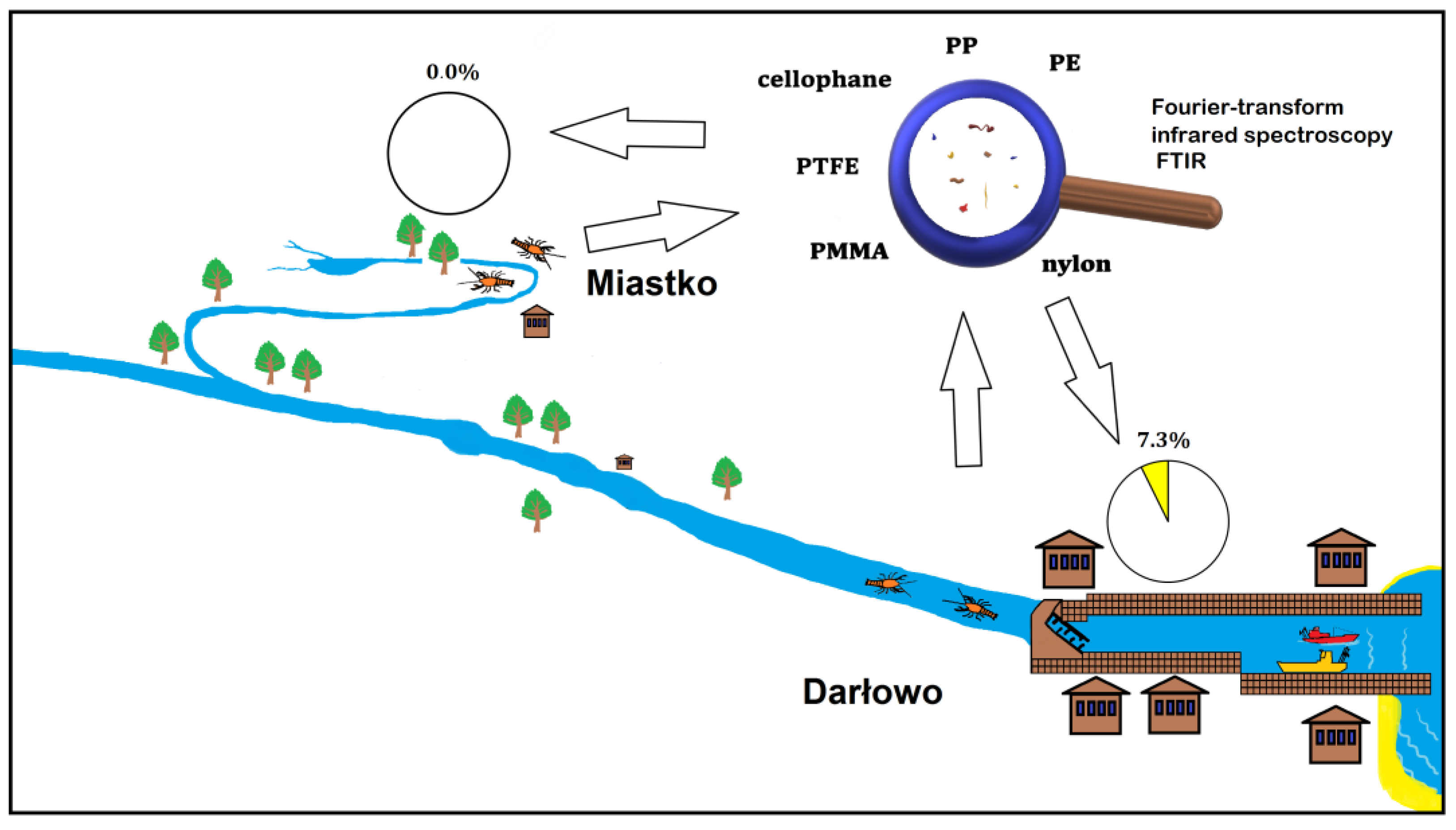

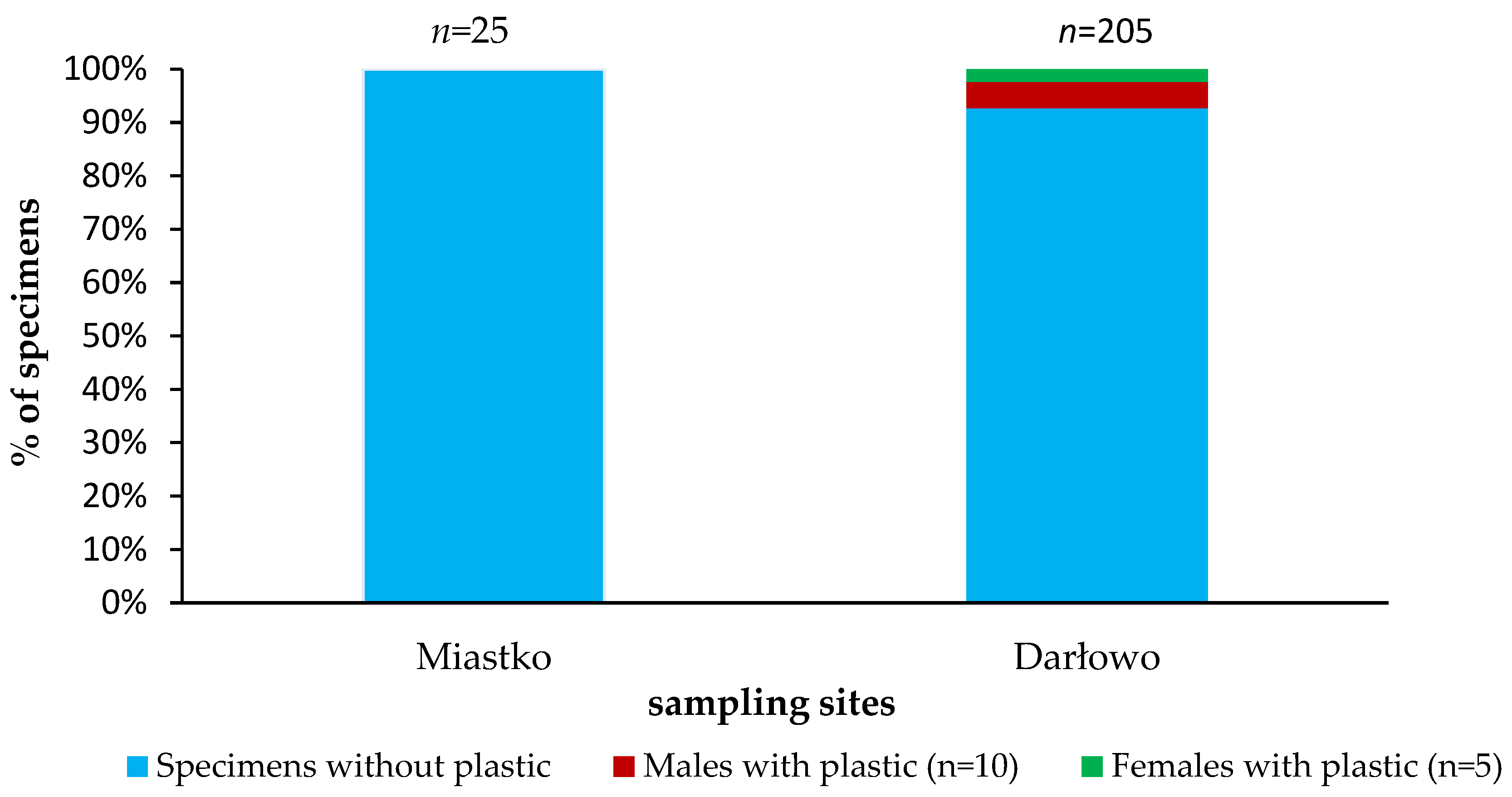
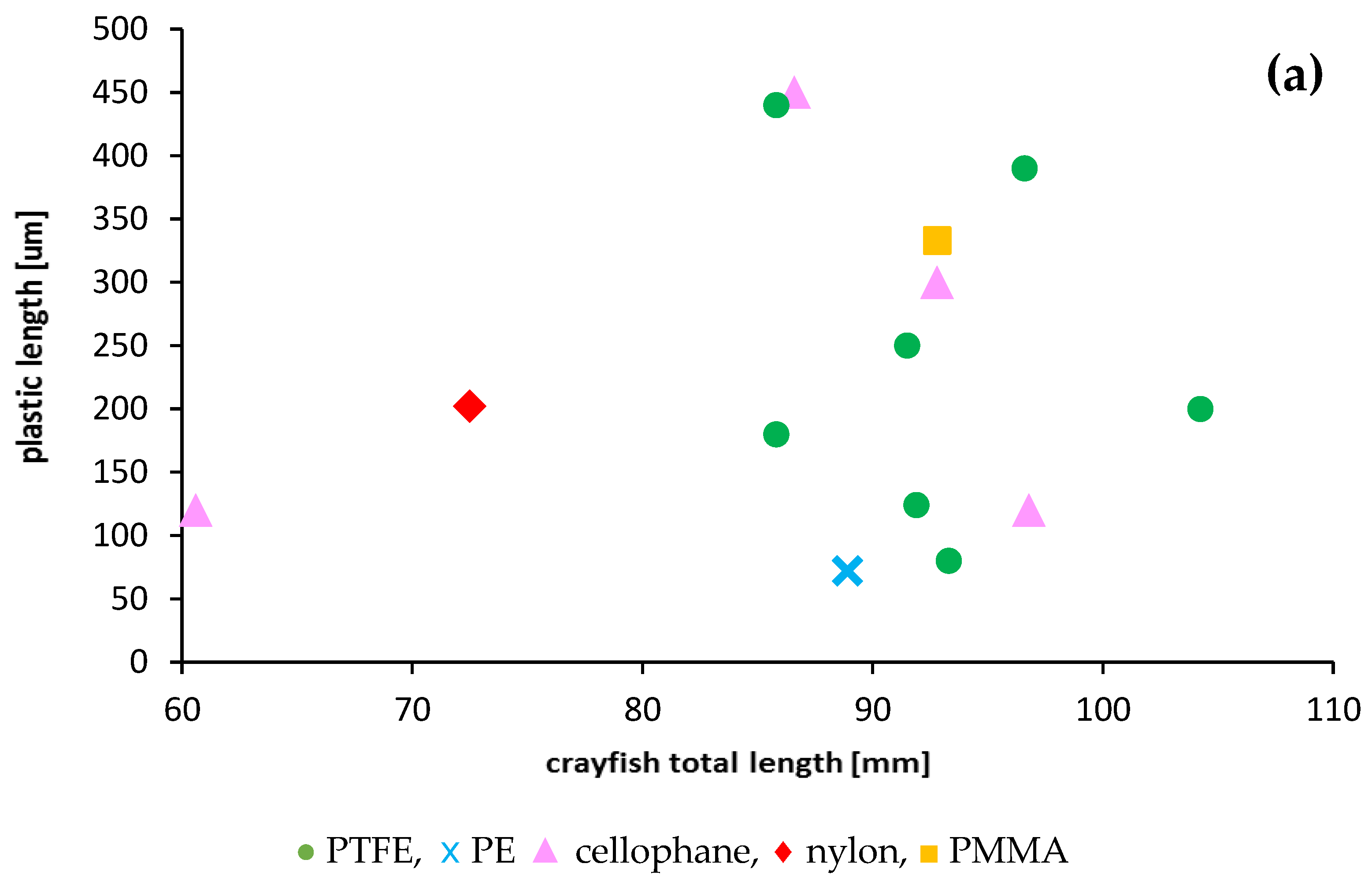
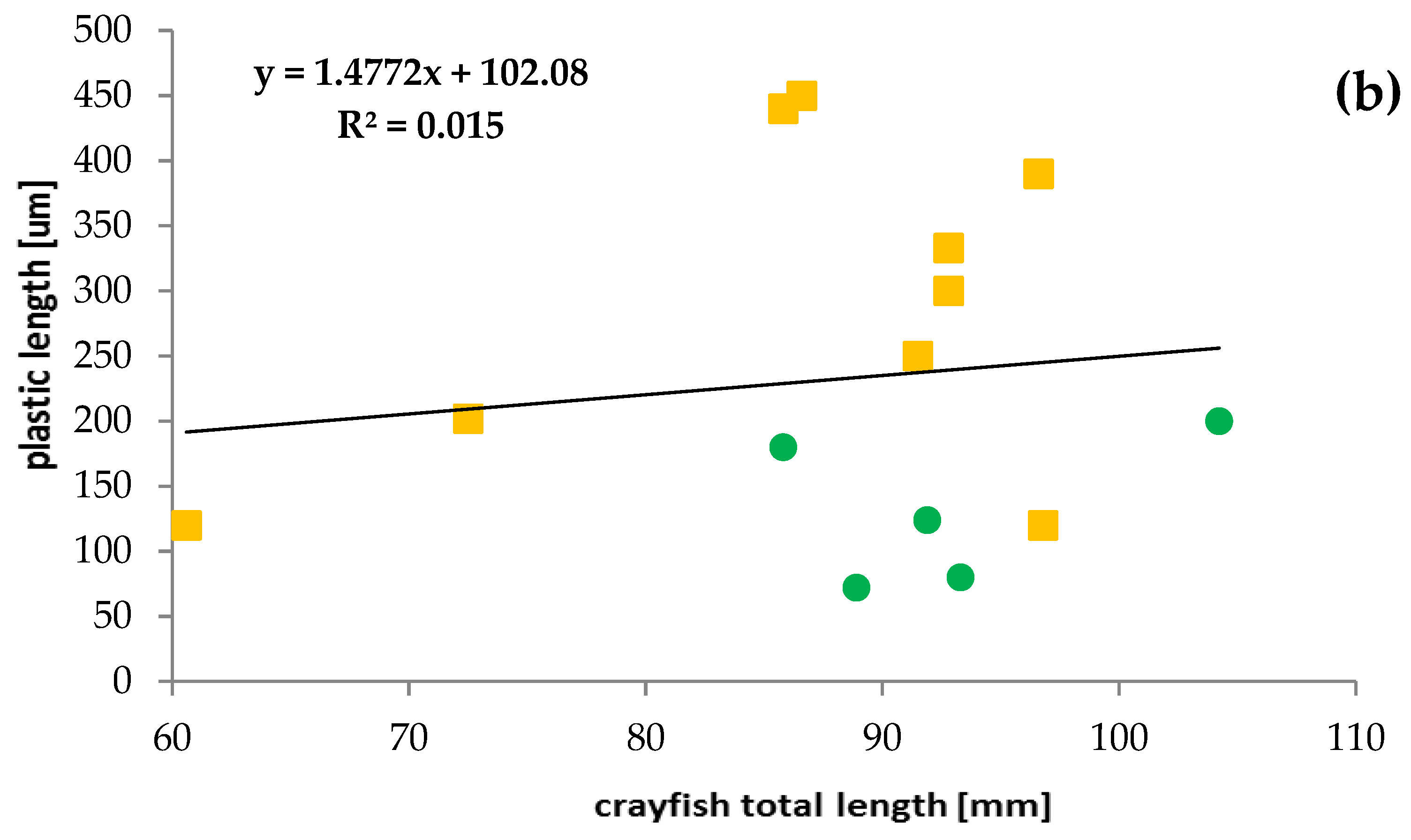

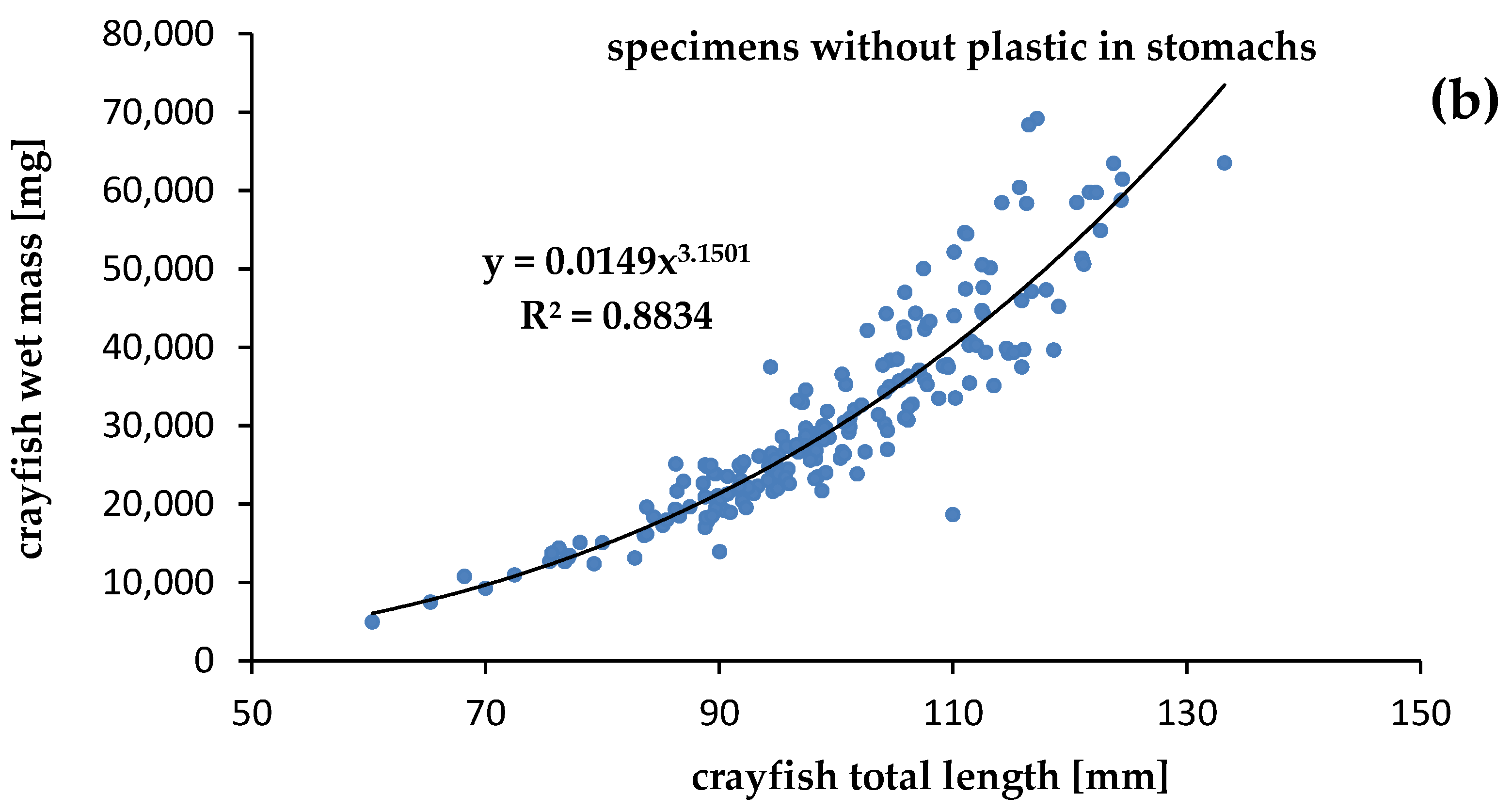
| Polymer | Size [µm] | Shape | Colour | Abundance |
|---|---|---|---|---|
| PTFE | 80−200 | Round | black | 1 ind−1 |
| PTFE | 390 | Round | black | 1 ind−1 |
| PP | 250 | Fibre | blue | 1 ind−1 |
| 440 | Fibre | red | 1 ind−1 | |
| PE | 72 | Round | transparent | 1 ind−1 |
| Cellophane | 300 | Fibre | pink | 1 ind−1 |
| 120−450 | Fibre | blue | 1 ind−1 | |
| 120 | Fibre | transparent | 1 ind−1 | |
| PMMA | 333 | Fibre | black | 1 ind−1 |
| Nylon | 202 | Fibre | black | 1 ind−1 |
Disclaimer/Publisher’s Note: The statements, opinions and data contained in all publications are solely those of the individual author(s) and contributor(s) and not of MDPI and/or the editor(s). MDPI and/or the editor(s) disclaim responsibility for any injury to people or property resulting from any ideas, methods, instructions or products referred to in the content. |
© 2024 by the authors. Licensee MDPI, Basel, Switzerland. This article is an open access article distributed under the terms and conditions of the Creative Commons Attribution (CC BY) license (https://creativecommons.org/licenses/by/4.0/).
Share and Cite
Dobrzycka-Krahel, A.; Skóra, M.E.; Pladzyk, A. Plastic Debris in the Stomach of the Invasive Signal Crayfish Pacifastacus leniusculus from a Baltic Coastal River. Water 2024, 16, 903. https://doi.org/10.3390/w16060903
Dobrzycka-Krahel A, Skóra ME, Pladzyk A. Plastic Debris in the Stomach of the Invasive Signal Crayfish Pacifastacus leniusculus from a Baltic Coastal River. Water. 2024; 16(6):903. https://doi.org/10.3390/w16060903
Chicago/Turabian StyleDobrzycka-Krahel, Aldona, Michał E. Skóra, and Agnieszka Pladzyk. 2024. "Plastic Debris in the Stomach of the Invasive Signal Crayfish Pacifastacus leniusculus from a Baltic Coastal River" Water 16, no. 6: 903. https://doi.org/10.3390/w16060903
APA StyleDobrzycka-Krahel, A., Skóra, M. E., & Pladzyk, A. (2024). Plastic Debris in the Stomach of the Invasive Signal Crayfish Pacifastacus leniusculus from a Baltic Coastal River. Water, 16(6), 903. https://doi.org/10.3390/w16060903






